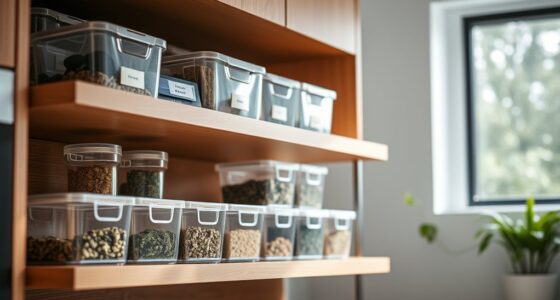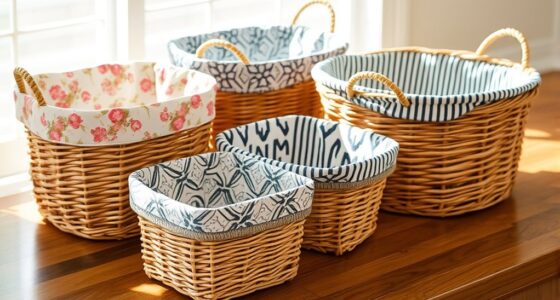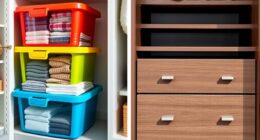If you want to effortlessly transform your space, I recommend focusing on clever organizational products like stackable bins, multifunctional furniture, and clear storage containers. Each of these items serves practical purposes while helping you reduce clutter. I've found that the right decluttering tools can boost efficiency and elevate your home's aesthetic. Curious about the best books to guide your decluttering journey? There's more to discover that could make your organizing adventure even smoother!
Key Takeaways
- Look for versatile storage solutions like stackable bins that can serve multiple purposes while maximizing space efficiency in your home.
- Choose durable and eco-friendly materials to ensure longevity and sustainability in your organizational products.
- Opt for aesthetically pleasing items that enhance your space's ambiance, promoting a tidy and inviting atmosphere.
- Prioritize products that require minimal assembly for immediate organization and ease of use during the decluttering process.
- Consider multifunctional products to reduce overall spending while maintaining an organized, clutter-free environment.
Tidy Spaces, Peaceful Mind: The Art of Decluttering

If you're feeling overwhelmed by clutter and crave a calmer, more organized space, "Tidy Spaces, Peaceful Mind" is the perfect guide for you. Jane Lee Miller's book transforms decluttering into a manageable process, focusing on micro-decluttering. Instead of tackling your entire home, you'll learn to zero in on small areas, making it less intimidating. By breaking tasks down, you can sort, categorize, and maintain organization effortlessly. This book doesn't just emphasize tidiness, but also its emotional benefits, reducing stress and fostering tranquility. You'll feel empowered and motivated to create a serene environment that enhances your overall well-being.
Best For: Individuals seeking a practical and manageable approach to decluttering their homes and lives for improved mental well-being.
Pros:
- Provides step-by-step strategies that make decluttering feel achievable and less overwhelming.
- Emphasizes the psychological benefits of a tidy environment, reducing stress and promoting peace.
- The casual and conversational writing style engages and motivates readers throughout the decluttering process.
Cons:
- Lacks real-life anecdotes and specific examples, particularly in the area of digital decluttering.
- Some sections may feel repetitive to certain readers, which could detract from overall engagement.
- Could benefit from additional support tools, such as sample routines or images, to enhance understanding of the methods.
Doable Decluttering Workbook: Proven Methods to Organize Your Home
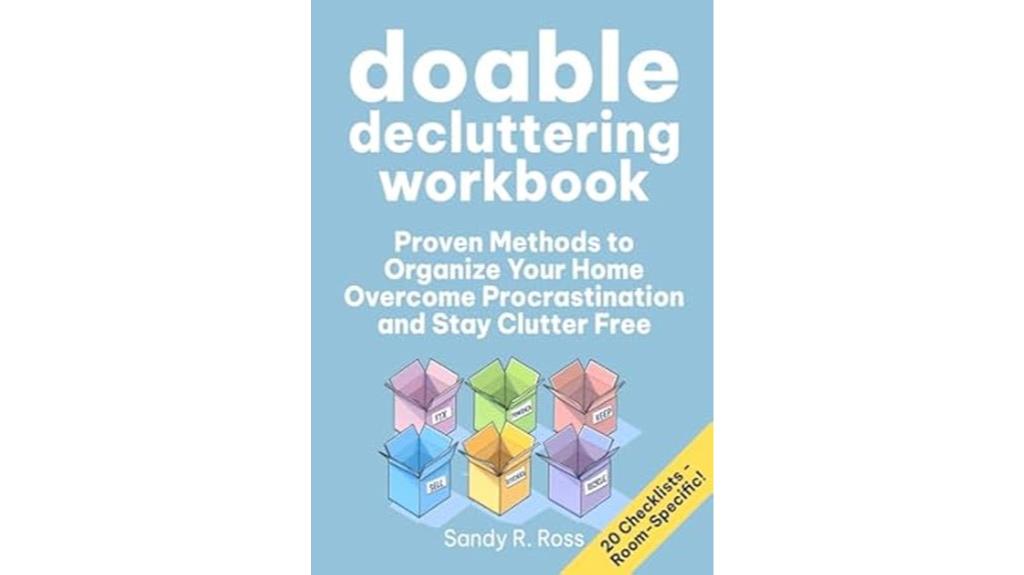
The "Doable Decluttering Workbook: Proven Methods to Organize Your Home" is perfect for anyone feeling overwhelmed by clutter but unsure where to begin. This workbook offers a step-by-step process that helps me tackle my space without feeling defeated. It dives into the emotional ties we have with our belongings, providing compassionate advice while encouraging practical decluttering strategies. The 6-Box System and room-by-room checklists make it manageable, and I love that I can adapt the methods to fit my personal pace. Plus, reading others' success stories inspires me to keep going. It's truly a supportive guide on my decluttering journey!
Best For: Individuals feeling overwhelmed by clutter who need a structured and compassionate approach to decluttering their homes.
Pros:
- Step-by-step process helps users tackle decluttering without feeling overwhelmed.
- Compassionate advice acknowledges emotional ties to belongings, making the process more relatable.
- Flexible methods allow users to adapt strategies to their own pace and preferences.
Cons:
- Some users may find certain strategies less effective for their unique situations.
- The workbook may require a time commitment that some individuals are not ready to invest.
- Not all tips may resonate with everyone, leading to potential frustration for some readers.
The Sentimental Persons Guide to Decluttering
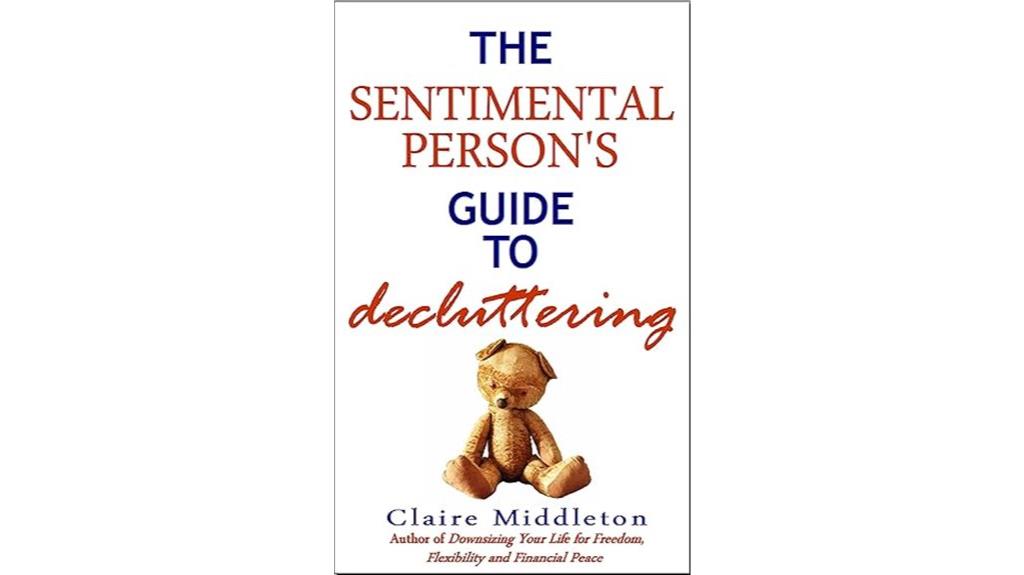
For anyone who struggles with letting go of sentimental items, "The Sentimental Persons Guide to Decluttering" offers a compassionate approach to maneuvering the emotional hurdles of decluttering. I found the book's strategies, like grouping similar items, incredibly helpful for taking inventory of my belongings. It truly resonates with those of us who feel overwhelmed by emotional attachments. The author encourages us to confront guilt when parting with gifts and belongings that no longer serve us. After reading, I felt inspired to take action, regain control, and simplify my space, making it a must-read for sentimental individuals like me.
Best For: Individuals who struggle with letting go of sentimental items and seek compassionate strategies for decluttering their belongings.
Pros:
- Offers practical strategies for organizing and managing possessions through grouping similar items.
- Addresses emotional aspects of decluttering, helping readers confront guilt associated with letting go of sentimental belongings.
- Inspires action and positive changes in approach to decluttering, making it relatable for those overwhelmed by clutter.
Cons:
- Some readers may find the content basic and lacking in new, innovative strategies.
- The focus on emotional connections may not resonate with individuals who are more pragmatic about decluttering.
- Not all readers may find the personal anecdotes relatable or helpful in their own decluttering journey.
Get Rid of the Mess: Decluttering Guide
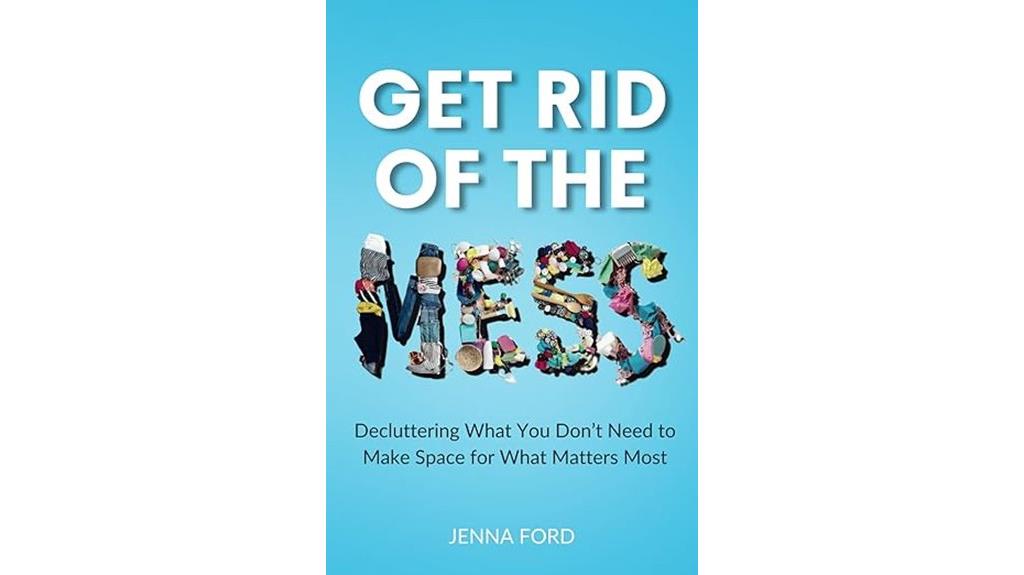
Overwhelmed by clutter and unsure where to start? "Get Rid of the Mess" is perfect for anyone feeling lost in their piles of belongings. This guide breaks down decluttering into simple, manageable steps, making it easy to reclaim your space. It dives into the psychological reasons behind our attachment to items, helping you tackle emotional barriers. With practical strategies like room-by-room approaches and helpful charts, you'll find it less intimidating. The author's empathetic tone resonates, encouraging you without judgment. Many readers have successfully transformed their spaces using these insights, and you can too! Let's get started on your decluttering journey!
Best For: Anyone feeling overwhelmed by clutter and looking for a structured approach to decluttering their space.
Pros:
- Practical Steps: Offers manageable, room-by-room strategies that simplify the decluttering process.
- Psychological Insights: Helps readers understand emotional attachments to items, addressing mindset challenges.
- Empathetic Tone: Creates a supportive atmosphere that motivates readers without judgment.
Cons:
- Time-Consuming: Implementing the strategies may require a significant time investment depending on the amount of clutter.
- Requires Commitment: Success depends on the reader's willingness to actively engage and maintain a clutter-free environment.
- May Not Suit All Styles: Some readers might prefer a more minimalistic approach rather than the detailed strategies provided.
Factors to Consider When Choosing The Decluttering Products That'll Revamp Your Space
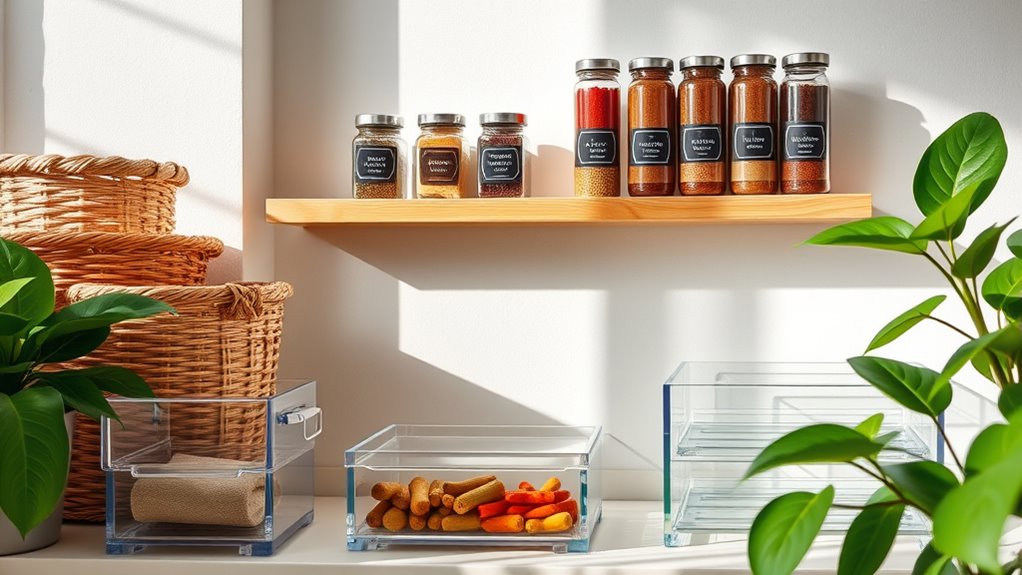
When I'm choosing decluttering products, I focus on several key factors that can transform my space. I consider the size and layout of my area, the quality of materials, and how versatile the items are. Plus, I always keep in mind the aesthetic appeal and my budget to guarantee I make the best choices.
Assess Your Space Needs
How can you effectively assess your space needs before diving into the decluttering process? I start by evaluating the size and layout of my space, pinpointing cluttered or underutilized areas. This helps me see where decluttering will have the most impact. Next, I consider the functionality of each area, focusing on essential spaces like the kitchen and workspace to boost daily efficiency. I also take stock of my items, categorizing them by how often I use them, which reveals what I can remove or reorganize. It's important to assess the emotional significance of belongings too; understanding my attachment can ease the decision to let go. Finally, I establish a clear purpose for each area to guide my decluttering efforts.
Durability and Quality Materials
Choosing the right decluttering products can make all the difference in creating a functional and organized space, especially when durability and quality materials are at the forefront of your decision. I've learned that opting for items made from reinforced plastics, sturdy metals, or natural fibers guarantees they withstand regular use without breaking down. Investing in durable products not only saves money over time but also keeps my space neat and tidy longer. Eco-friendly materials often promise higher durability, making them a smart choice for sustainability enthusiasts like me. It's crucial to find a balance between weight and sturdiness, so storage solutions can hold their contents securely without collapsing. Prioritizing these factors truly transforms cluttered areas into organized sanctuaries.
Versatility and Functionality Options
While exploring decluttering products, I quickly realized that versatility and functionality are key to transforming my space. I look for items that serve multiple purposes, like storage bins that double as seating or decor. Functional designs, such as stackable organizers, maximize space efficiency, especially in smaller areas. I appreciate products with adjustable compartments or modular designs, which allow me to customize organization based on my needs. Clear storage containers are a game-changer, making it easy to identify contents without digging around. Finally, I prioritize items that are easy to clean and maintain, ensuring they stay functional and visually appealing over time. These factors greatly enhance the usability of my decluttering products, making my space feel more organized and inviting.
Aesthetic Appeal and Design
After considering versatility and functionality in decluttering products, I've come to appreciate the significance of aesthetic appeal and design. When I choose storage solutions, I look for colors and styles that enhance my home's ambiance, creating an inviting atmosphere. Well-designed products not only serve a purpose but also add beauty to my space. I've noticed that aesthetically pleasing items encourage me to stay organized; it's easier to maintain tidiness when the products align with my personal taste. Incorporating different textures, shapes, and proportions adds visual interest, making organization enjoyable. Ultimately, a thoughtful selection leads to a cohesive look throughout my home, fostering a sense of peace and tranquility in my living space.
Budget and Cost Considerations
Understanding the budget and cost considerations when selecting decluttering products is essential for creating an organized space without overspending. I've learned that it's important to factor in not just the initial purchase price but also any long-term costs, like replacements or repairs. Investing in high-quality products can save money over time, as I discovered that 70% of people found this approach effective. Setting a clear budget helps prioritize essential items, and sticking to it can boost your chances of maintaining a clutter-free space by 30%. Plus, consider multifunctional products; they can cut overall spending by about 25%. Finally, don't underestimate potential replacement costs from damage due to clutter, which can add 15-20% to your budget.
Ease of Assembly and Use
How can the ease of assembly and use impact your decluttering efforts? When I choose decluttering products, I always prioritize those that require minimal setup time. It makes it so much easier to start organizing right away. User-friendly designs are a must; I want products that allow for straightforward access and reduce frustration during use. Clear instructions and visual aids can really boost my confidence while assembling. I also consider portability; lightweight items are easier to move and rearrange, which keeps the decluttering process dynamic. Finally, I look for versatile products that serve multiple purposes. This adaptability not only enhances usability but also cuts down on the clutter of having too many items.
Storage Capacity and Organization
While ease of assembly and use set the foundation for an effective decluttering process, the next step involves selecting products with the right storage capacity and organization features. I've found that larger containers can hold more items, but they may require additional space, while smaller options encourage minimalism. It's crucial to choose products that allow for compartmentalization, as categorizing items makes retrieval easier and keeps everything in order.
Always assess the dimensions of your space to guarantee the products fit well, avoiding overcrowding. Multi-functional solutions, like those that double as seating or shelving, can optimize small areas. Finally, consider materials; transparent containers not only enhance durability but also allow for easy visibility of contents, boosting organization efforts.
Frequently Asked Questions
What Are the Best Eco-Friendly Decluttering Products Available?
I've found some fantastic eco-friendly decluttering products that really help me keep my space organized. Reusable storage bags made from recycled materials are a game-changer for reducing waste. I also love bamboo storage bins; they're stylish and sustainable. Compostable trash bags are a must-have for any decluttering project. Finally, I recommend using glass containers for food storage to cut down on plastic. These choices not only declutter my home but also support the planet!
How Do I Maintain a Clutter-Free Space After Organizing?
To maintain a clutter-free space after organizing, I stick to a routine. I set aside a few minutes each day to put things back in their designated spots. I also avoid bringing in unnecessary items by practicing the one-in, one-out rule. Regularly reassessing my belongings helps too; if I haven't used something in months, I let it go. Staying mindful about my space keeps it tidy and peaceful.
Can Decluttering Improve Mental Health?
Imagine walking into a room that feels lighter, where every item serves a purpose. I've found that decluttering can truly improve mental health. When I clear out excess, I feel a sense of relief and clarity. It's like lifting a weight off my shoulders. A tidy space reduces stress, sparks creativity, and fosters focus. So, if you're feeling overwhelmed, start small—decluttering might just be the fresh start you need.
What Are Some Budget-Friendly Decluttering Solutions?
When I look for budget-friendly decluttering solutions, I focus on creativity and practicality. I often use boxes or bins I already have to organize items, and I repurpose old containers for storage. Thrift stores are great for finding affordable shelves or baskets. I also embrace the "one in, one out" rule to keep clutter at bay. It's amazing how a little effort can make a big difference without breaking the bank!
How Often Should I Declutter My Home?
I usually declutter my home every three to six months, but it really depends on how much stuff I accumulate. I've found that setting a regular schedule helps me stay organized and prevents overwhelm. Whenever I notice clutter piling up, I tackle it right away. I recommend keeping a checklist of areas to focus on, so I don't miss anything. Regular decluttering keeps my space feeling fresh and functional.
Conclusion
As I sifted through my cluttered space, I stumbled upon a long-forgotten keepsake that sparked joy, reminding me of the transformative power of decluttering. With these four essential products, I found not just organization but a newfound clarity in my environment. Coincidentally, as I decluttered, I also decluttered my mind, paving the way for peace and creativity. So, why not embrace this journey? Your serene space awaits, just a few thoughtful choices away.




